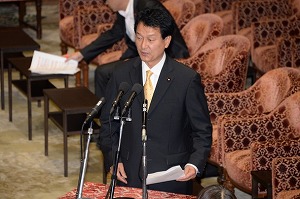 |
2015/07/08
Oshima explains gist of Territorial Security Act to the Diet
|



DPJ Diet member Atsushi Oshima represents the the bill to the Lower House
|
On July 8, DPJ Diet member Atsushi Oshima represented the bill sponsors in outlining the proposal for a Territorial Security Act to a session of the House of Representatives Special Committee on Legislation for the Peace and Security of Japan and the International Community. The legislation had been jointly submitted to the Diet that same day by the DPJ and the Japan Innovation Party.
Oshima raised the matter of grey zone situations, situations which are envisaged to be a realistic and pressing threat requiring a response by the SDF but do not amount to an armed attack. One example would be an infringement by an armed fishing vessel, which could not be dealt with by the Japan Coastguard or other police authorities, occurring in Japan’s remote islands. In such a case, for the SDF to deploy for the purpose of either maintaining public order or for maritime police actions, current legislation has three gaps relating to time to respond, authorities and the use of weapons.
Oshima emphasized that filling in these three gaps in the legislation and making a seamless response possible is the most important action that needs to be taken in order to properly protect the lives and possessions of the Japanese people and Japan’s territory and territorial waters. The government response to the question of grey zone situations has been limited to announcing operational improvements such as implementing teleconferencing for Cabinet meetings, and the proposed security legislation now under debate in the Diet does not contain any legislative measures for dealing with such issues. Oshima described the reason for submitting the Territorial Security Act to the Diet as follows: “Based on the stance of pursuing truly realistic security policies, we believe it necessary, from the perspective of [a defense policy] ‘realistic in Japan’s vicinity’ to establish clear legal grounds that fill in the gaps.”
|
|
|
 |
|